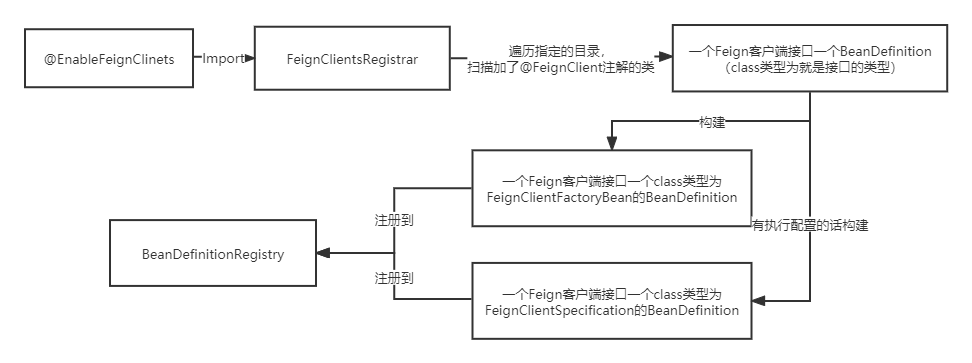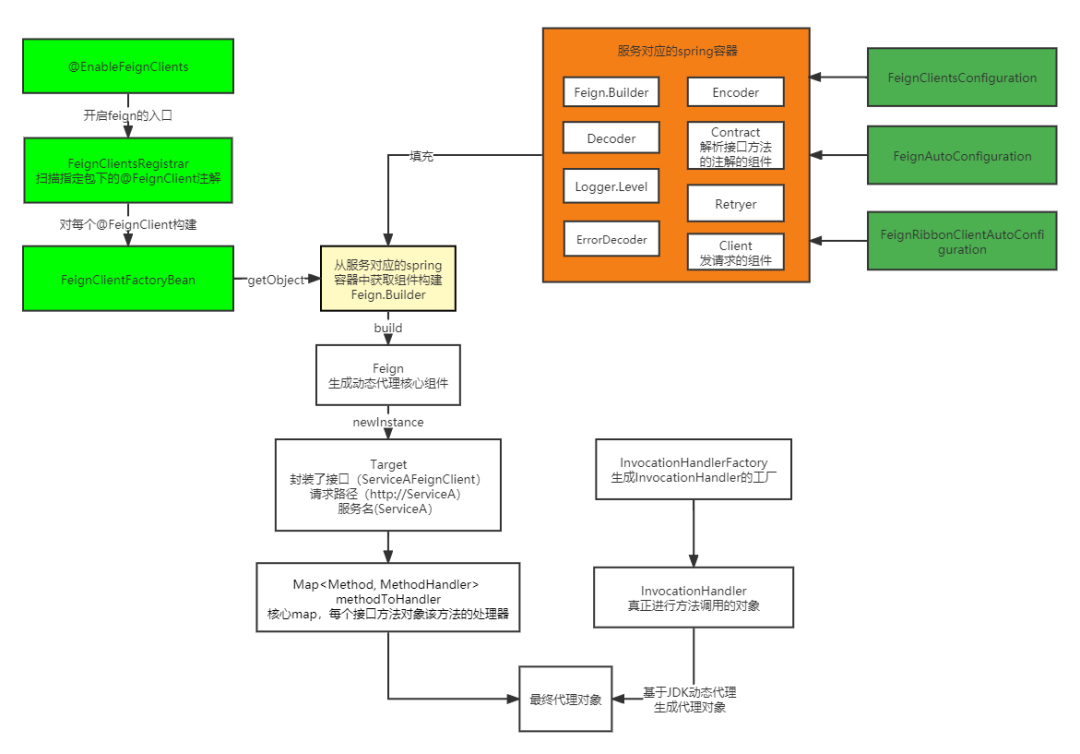Java SpringCloudOpenFeignFeignClient
一、@EnableFeignClinets作用源码剖析
要使用feign,必须要使用@EnableFeignClinets来激活,这个注解其实就是整个feign的入口,接下来着重分析一下这个注解干了什么事。
@Retention(RetentionPolicy.RUNTIME)@Target(ElementType.TYPE)@Documented@Import(FeignClientsRegistrar.class)public @interface EnableFeignClients {}
这个注解通过@Import注解导入一个配置类FeignClientsRegistrar.class,FeignClientsRegistrar实现了ImportBeanDefinitionRegistrar接口,所以Spring Boot在启动的时候,会去调用FeignClientsRegistrar类中的registerBeanDefinitions来动态往spring容器中注入bean。
接下来看一下registerBeanDefinitions的实现
@Overridepublic void registerBeanDefinitions(AnnotationMetadata metadata,BeanDefinitionRegistry registry)//这个方式是注入一些配置,就是对EnableFeignClients注解属性的解析registerDefaultConfiguration(metadata, registry);//这个方法是扫秒加了@FeignClient注解registerFeignClients(metadata, registry);}
这里着重分析registerFeignClients,看一看是如何扫描@FeignClient注解的,然后扫描到之后又做了什么。
public void registerFeignClients(AnnotationMetadata metadata,BeanDefinitionRegistry registry) {ClassPathScanningCandidateComponentProvider scanner = getScanner();scanner.setResourceLoader(this.resourceLoader);Set<String> basePackages;Map<String, Object> attrs = metadata.getAnnotationAttributes(EnableFeignClients.class.getName());AnnotationTypeFilter annotationTypeFilter = new AnnotationTypeFilter(FeignClient.class);final Class<?>[] clients = attrs == null ? null: (Class<?>[]) attrs.get("clients");if (clients == null || clients.length == 0) {scanner.addIncludeFilter(annotationTypeFilter);basePackages = getBasePackages(metadata);}else {final Set<String> clientClasses = new HashSet<>();basePackages = new HashSet<>();for (Class<?> clazz : clients) {basePackages.add(ClassUtils.getPackageName(clazz));clientClasses.add(clazz.getCanonicalName());}AbstractClassTestingTypeFilter filter = new AbstractClassTestingTypeFilter() {@Overrideprotected boolean match(ClassMetadata metadata) {String cleaned = metadata.getClassName().replaceAll("\\$", ".");return clientClasses.contains(cleaned);}};scanner.addIncludeFilter(new AllTypeFilter(Arrays.asList(filter, annotationTypeFilter)));}for (String basePackage : basePackages) {Set<BeanDefinition> candidateComponents = scanner.findCandidateComponents(basePackage);for (BeanDefinition candidateComponent : candidateComponents) {if (candidateComponent instanceof AnnotatedBeanDefinition) {// verify annotated class is an interfaceAnnotatedBeanDefinition beanDefinition = (AnnotatedBeanDefinition) candidateComponent;AnnotationMetadata annotationMetadata = beanDefinition.getMetadata();Assert.isTrue(annotationMetadata.isInterface(),"@FeignClient can only be specified on an interface");Map<String, Object> attributes = annotationMetadata.getAnnotationAttributes(FeignClient.class.getCanonicalName());String name = getClientName(attributes);registerClientConfiguration(registry, name,attributes.get("configuration"));registerFeignClient(registry, annotationMetadata, attributes);}}}}
这段代码分析一下,先获取到了一个ClassPathScanningCandidateComponentProvider这个对象,这个对象是按照一定的规则来扫描指定目录下的类的,符合这个规则的每个类,会生成一个BeanDefinition。
获取到ClassPathScanningCandidateComponentProvider对象,配置这个对象,指定这个对象需要扫描出来标有@FeignClient注解的类;随后解析EnableFeignClients注解,获取内部的属性,获取到指定的需要扫描包路径下,如果没有指定的,那么就默认是当前注解所在类的所在目录及子目录。
然后就遍历每个目录,找到每个标有@FeignClient注解的类,对每个类就生成一个BeanDefinition,可以把BeanDefinition看成对每个标有@FeignClient注解的类信息的封装。
拿到一堆BeanDefinition之后,会遍历BeanDefinition,然后调用registerClientConfiguration和registerFeignClient方法。
接下来分别剖析一下这两个方法的作用**registerClientConfiguration**:
private void registerClientConfiguration(BeanDefinitionRegistry registry, Object name,Object configuration) {BeanDefinitionBuilder builder = BeanDefinitionBuilder.genericBeanDefinition(FeignClientSpecification.class);builder.addConstructorArgValue(name);builder.addConstructorArgValue(configuration);registry.registerBeanDefinition(name + "." + FeignClientSpecification.class.getSimpleName(),builder.getBeanDefinition());}
这里的作用就是拿出在@FeignClient指定的配置类,也就是configuration属性,然后构建一个bean class为FeignClientSpecification,传入配置。这个类的最主要作用就是将每个Feign的客户端的配置类封装成一个FeignClientSpecification的BeanDefinition,注册到spring容器中。记住这个FeignClientSpecification,后面会有用。
registerFeignClient:
private void registerFeignClient(BeanDefinitionRegistry registry,AnnotationMetadata annotationMetadata, Map<String, Object> attributes) {String className = annotationMetadata.getClassName();BeanDefinitionBuilder definition = BeanDefinitionBuilder.genericBeanDefinition(FeignClientFactoryBean.class);validate(attributes);definition.addPropertyValue("url", getUrl(attributes));definition.addPropertyValue("path", getPath(attributes));String name = getName(attributes);definition.addPropertyValue("name", name);String contextId = getContextId(attributes);definition.addPropertyValue("contextId", contextId);definition.addPropertyValue("type", className);definition.addPropertyValue("decode404", attributes.get("decode404"));definition.addPropertyValue("fallback", attributes.get("fallback"));definition.addPropertyValue("fallbackFactory", attributes.get("fallbackFactory"));definition.setAutowireMode(AbstractBeanDefinition.AUTOWIRE_BY_TYPE);String alias = contextId + "FeignClient";AbstractBeanDefinition beanDefinition = definition.getBeanDefinition();boolean primary = (Boolean) attributes.get("primary"); // has a default, won't be// nullbeanDefinition.setPrimary(primary);String qualifier = getQualifier(attributes);if (StringUtils.hasText(qualifier)) {alias = qualifier;}BeanDefinitionHolder holder = new BeanDefinitionHolder(beanDefinition, className,new String[] { alias });BeanDefinitionReaderUtils.registerBeanDefinition(holder, registry);}
registerFeignClient这个方法很重要,来说一下大概做了哪些事。重新构造了一个BeanDefinition,这个BeanDefinition的指定的class类型是FeignClientFactoryBean,这个类实现了FactoryBean接口,对spring有一定了解的小伙伴应该知道,spring在生成bean的时候,判断BeanDefinition中bean的class如果是FactoryBean的实现的话,会调用这个实现类的getObject来获取对象。
到这一步,@EnableFeignClinets的作用就说完了。这个类的主要作用是扫描指定(不指定就默认路径下的)所有加了@FeignClient注解的类,然后每个类都会生成一个BeanDefinition,随后遍历每个BeanDefinition,然后取出每个@FeignClient注解的属性,构造新的BeanDefinition,传入FeignClientFactoryBean的class,随后注入到spring容器中;同时有配置类的也会将配置类构件出一个bean class为FeignClientSpecification的BeanDefinition注入到spring容器中。
为了便于理解,这里画个图来总结一下这个注解干了什么事。
二、Feign客户端接口动态代理的生成源码剖析
(1)FeignAutoConfiguration源码剖析
FeignAutoConfiguration是feign在整个springcloud的配置类,拎出这里面比较核心的代码。
@Autowired(required = false)private List<FeignClientSpecification> configurations = new ArrayList<>();@Beanpublic FeignContext feignContext() {FeignContext context = new FeignContext();context.setConfigurations(this.configurations);return context;}
注入了一堆FeignClientSpecification,FeignClientSpecification这玩意就是上文提到的调用registerClientConfiguration的时候注入到spring容器中的,一个Feign客户端的配置一个FeignClientSpecification,所以是个集合,然后封装到FeignContext中,最后将FeignContext注入到spring容器中。FeignContext也是很重要的一个东西,来分析一下它的源码
public class FeignContext extends NamedContextFactory<FeignClientSpecification> {public FeignContext() {super(FeignClientsConfiguration.class, "feign", "feign.client.name");}}
FeignContext继承了NamedContextFactory,构造的时候,传入了FeignClientsConfiguration,这个也很重要,来分析它们的作用。
(2)NamedContextFactory源码剖析
先来说结论,NamedContextFactory的作用是用来进行配置隔离的,ribbon和feign的配置隔离都依赖这个抽象类。
何为配置隔离,因为每个Feign客户端都有可能有自己的配置,从@FeignClient注解的属性configuration可以看出,所以写了这个类,用来隔离每个客户端的配置,这就是为什么在构造FeignContext传入一堆FeignClientSpecification的原因,这里封装了每个客户端的配置类。
那是怎么实现的呢,拎出来一部分核心的源码,不重要的就忽略了。
public abstract class NamedContextFactory<C extends NamedContextFactory.Specification>implements DisposableBean, ApplicationContextAware {private final String propertySourceName;private final String propertyName;private Map<String, AnnotationConfigApplicationContext> contexts = new ConcurrentHashMap<>();private Map<String, C> configurations = new ConcurrentHashMap<>();//父类 ApplicationContext ,也就是springboot所使用的ApplicationContextprivate ApplicationContext parent;// 这个是默认的额配置类private Class<?> defaultConfigType;public NamedContextFactory(Class<?> defaultConfigType, String propertySourceName,String propertyName) {this.defaultConfigType = defaultConfigType;this.propertySourceName = propertySourceName;this.propertyName = propertyName;}@Overridepublic void setApplicationContext(ApplicationContext parent) throws BeansException {this.parent = parent;}public void setConfigurations(List<C> configurations) {for (C client : configurations) {this.configurations.put(client.getName(), client);}}public Set<String> getContextNames() {return new HashSet<>(this.contexts.keySet());}protected AnnotationConfigApplicationContext getContext(String name) {if (!this.contexts.containsKey(name)) {synchronized (this.contexts) {if (!this.contexts.containsKey(name)) {this.contexts.put(name, createContext(name));}}}return this.contexts.get(name);}protected AnnotationConfigApplicationContext createContext(String name) {AnnotationConfigApplicationContext context = new AnnotationConfigApplicationContext();if (this.configurations.containsKey(name)) {for (Class<?> configuration : this.configurations.get(name).getConfiguration()) {context.register(configuration);}}for (Map.Entry<String, C> entry : this.configurations.entrySet()) {if (entry.getKey().startsWith("default.")) {for (Class<?> configuration : entry.getValue().getConfiguration()) {context.register(configuration);}}}context.register(PropertyPlaceholderAutoConfiguration.class,this.defaultConfigType);context.getEnvironment().getPropertySources().addFirst(new MapPropertySource(this.propertySourceName,Collections.<String, Object>singletonMap(this.propertyName, name)));if (this.parent != null) {// Uses Environment from parent as well as beanscontext.setParent(this.parent);// jdk11 issue// https://github.com/spring-cloud/spring-cloud-netflix/issues/3101context.setClassLoader(this.parent.getClassLoader());}context.setDisplayName(generateDisplayName(name));context.refresh();return context;}/*** Specification with name and configuration.*/public interface Specification {String getName();Class<?>[] getConfiguration();}}
分析一下每个成员变量的作用:
**contexts**: 一个客户端一个对应的AnnotationConfigApplicationContext**configurations**: 一个客户端一个配置类的封装,对应到Feign的就是FeignClientSpecification**parent**: springboot真正启动的就是这个ApplicationContext**defaultConfigType**: 默认的配置类,对应Feign就是构造FeignContext是传入的FeignClientsConfiguration
分析一下核心的方法:**getContext**:这个方法很简单,就是根据客户端名称从contexts获取对应的AnnotationConfigApplicationContext,获取不到就去创建一个,然后放入contexts**createContext**:就是直接new了一个AnnotationConfigApplicationContext对象,然后按照按照配置的优先级顺序,一步步放入配置类,最后放入parent容器,也就是说每个客户端对应的容器,都有一个共同的父容器,同时如果每个客户端对应的容器获取不到的配置,都会再次从父容器中获取。这个结论还是很重要的。
其实所谓的配置隔离就是为每个客户端构建一个AnnotationConfigApplicationContext,然后基于这个ApplicationContext来解析配置类,这样就实现了配置隔离。
不知道大家有么有遇到过这个坑,就是在spring cloud环境中,监听类似ContextRefreshedEvent这种事件的时候,这个事件会无缘无故地触发很多次,其实就是这个原因就在这,因为spring的事件是有传播机制的,每个客户端对应的容器都要进行refresh,refresh完就会发这个事件,然后这个事件就会传给parent容器,也就是springboot启动的容器,就会再次触发,所以如果客户端很多,那么就会触发很多次。解决办法就是进行唯一性校验,只能启动一次就行了。
(3)FeignClientsConfiguration源码剖析
说完NamedContextFactory,接下来说一下FeignClientsConfiguration的作用。
这是一个默认的配置类,里面配置了很多bean,这些bean都是生成Feign客户端动态代理的需要的,说几个重要的。
@Bean@ConditionalOnMissingBeanpublic Contract feignContract(ConversionService feignConversionService) {return new SpringMvcContract(this.parameterProcessors, feignConversionService);}
这个的主要作用是用来解析@FeignClient接口中每个方法使用的springmvc的注解的,这也就是为什么FeignClient可以识别springmvc注解的原因。
@Bean@Scope("prototype")@ConditionalOnMissingBeanpublic Feign.Builder feignBuilder(Retryer retryer) {return Feign.builder().retryer(retryer);}
用来构建动态代理的类,通过这个类的target方法,就能生成Feign动态代理
@Configuration(proxyBeanMethods = false)@ConditionalOnClass({ HystrixCommand.class, HystrixFeign.class })protected static class HystrixFeignConfiguration {@Bean@Scope("prototype")@ConditionalOnMissingBean@ConditionalOnProperty(name = "feign.hystrix.enabled")public Feign.Builder feignHystrixBuilder() {return HystrixFeign.builder();}}
这个是FeignClientsConfiguration的内部类,是用来整合hystrix的,@ConditionalOnProperty(name = "feign.hystrix.enabled"),当在配置文件配置了feign.hystrix.enabled=true的时候,就开启了hystrix整合了Feign,然后调用Feign的接口就有了限流、降级的功能。
其实hystrix整合Feign很简单,就是在构造动态代理的时候加了点东西而已。其实不光是hystrix,spring cloud alibaba中的sentinel在整合Feign的适合也是按照这个套路来的。
(4)构建动态代理的过程源码剖析
说完了前置的内容,接下来就来看一看动态代理是如何生成的。从上面已经知道了,@EnableFeignClinets会扫描出每个加了@FeignClient注解的接口,然后生成对应的BeanDefinition,最后重新生成一个bean class为FeignClientFactoryBean的BeanDefinition,注册到spring容器。
接下来就会根据BeanDefinition来生成feign客户端的代理对象了。上面提到,是通过FeignClientFactoryBean的getObject方法来获取到代理对象,接下来,就来着重分析一下getObject方法的实现。
@Overridepublic Object getObject() throws Exception {return getTarget();}
getObject是调用getTarget()来获取代理对象的。getTarget方法
<T> T getTarget() {FeignContext context = this.applicationContext.getBean(FeignContext.class);Feign.Builder builder = feign(context);if (!StringUtils.hasText(this.url)) {if (!this.name.startsWith("http")) {this.url = "http://" + this.name;}else {this.url = this.name;}this.url += cleanPath();return (T) loadBalance(builder, context,new HardCodedTarget<>(this.type, this.name, this.url));}if (StringUtils.hasText(this.url) && !this.url.startsWith("http")) {this.url = "http://" + this.url;}String url = this.url + cleanPath();Client client = getOptional(context, Client.class);if (client != null) {if (client instanceof LoadBalancerFeignClient) {// not load balancing because we have a url,// but ribbon is on the classpath, so unwrapclient = ((LoadBalancerFeignClient) client).getDelegate();}if (client instanceof FeignBlockingLoadBalancerClient) {// not load balancing because we have a url,// but Spring Cloud LoadBalancer is on the classpath, so unwrapclient = ((FeignBlockingLoadBalancerClient) client).getDelegate();}builder.client(client);}Targeter targeter = get(context, Targeter.class);return (T) targeter.target(this, builder, context,new HardCodedTarget<>(this.type, this.name, url));}
先从ioc容器中获取到FeignContext,FeignContext里面封装了每个Feign的配置,起到配置隔离的作用。
然后获取到一个Feign.Builder,默认是在FeignClientsConfiguration中配置的。然后调用feign方法。
protected Feign.Builder feign(FeignContext context) {FeignLoggerFactory loggerFactory = get(context, FeignLoggerFactory.class);Logger logger = loggerFactory.create(this.type);// @formatter:offFeign.Builder builder = get(context, Feign.Builder.class)// required values.logger(logger).encoder(get(context, Encoder.class)).decoder(get(context, Decoder.class)).contract(get(context, Contract.class));// @formatter:on//这个是从配置文件中读取feign的配置configureFeign(context, builder);return builder;}
这个方法很简单,就是从每个FeignClient对应的ioc容器中获取到对应的组件,填充到 Feign.Builder中,默认都是FeignClientsConfiguration配置的。configureFeign这个方法不用去care它,它是默认从配置文件读取feign的配置,然后对Feign.Builder进行配置,有可能会覆盖从每个FeignClient对应的ioc容器中获取到对应的组件,所以配置文件的优先级是最高的,但是一般没人这么玩,所以就不用担心。
上面获取到的各种组件都是默认的,如果有需要替换什么组件,都可以实现,然后通过@FeignClient的configuration配置,就可以替换这些组件。
接下来就是走这段代码
if (!StringUtils.hasText(this.url)) {if (!this.name.startsWith("http")) {this.url = "http://" + this.name;}else {this.url = this.name;}this.url += cleanPath();return (T) loadBalance(builder, context,new HardCodedTarget<>(this.type, this.name, this.url));}
这段代码就是判断有没有指定url,url在哪指定的呢,就是在@FeignClient注解中指定的url属性,这个属性是主要是进行feign直连,什么叫直连,就是不通过注册中心,直接访问服务提供者,这个url就是配置服务提供者的ip和端口。在springcloud环境下,一般这个是不配置的,因为得从注册中心发现服务所在的ip和端口列表。所以从这y也可以看出,没有注册中心,feign也是能够跑的,只要指定服务提供者的ip和端口就行。
所以,一般这个url是空的,也就是会进入这段代码。其实很简单,就是配置一个url,name是服务名,也是在@FeignClient配置的。那这段代码什么意思呢,举个例子来说,假如服务名是ServiceA,那么拼出来就是 http://ServiceA ,就是这么简单。得到url之后就会走loadBalance方法,传入一个HardCodedTarget参数,这个参数是封装了Feign客户端接口的类型、服务的名称、还有刚构建的url,接下来进入loadBalance。
protected <T> T loadBalance(Feign.Builder builder, FeignContext context,HardCodedTarget<T> target) {Client client = getOptional(context, Client.class);if (client != null) {builder.client(client);Targeter targeter = get(context, Targeter.class);return targeter.target(this, builder, context, target);}throw new IllegalStateException("No Feign Client for loadBalancing defined. Did you forget to include spring-cloud-starter-netflix-ribbon?");}
这个方法一上来就从feign客户端对应的ioc容器中获取一个Client,但是FeignClientsConfiguration里面没有配置Client这个bean,那是从哪来呢?
其实loadBalance这个方法名就可以想到是负载均衡,所以Client需要整合负载均衡的功能,说到负载均衡,当前优先想到ribbon,所以就引入了FeignRibbonClientAutoConfiguration这个配置类,这个类是Feign整合ribbon的配置类,当然目前来说,负载均衡组件不止ribbon,还有springcloud自己实现的spring-cloud-starter-loadbalancer这个组件,其实原理都是一样的。
这里就默认获取到了Client,那么接下来就放入Feign.Builder中,接下来获取到Targeter,Targeter是通过FeignAutoConfiguration来配置的,默认是DefaultTargeter,如果整合hystrix就需是HystrixTargeter,当然这里就是默认的DefaultTargeter。
接下来就会调用DefaultTargeter的target方法
@Overridepublic <T> T target(FeignClientFactoryBean factory, Feign.Builder feign,FeignContext context, Target.HardCodedTarget<T> target) {return feign.target(target);}
就是直接调用Feign.Builder的tartget方法,那么就进入这个方法
public <T> T target(Target<T> target) {return build().newInstance(target);}public Feign build() {SynchronousMethodHandler.Factory synchronousMethodHandlerFactory =new SynchronousMethodHandler.Factory(client, retryer, requestInterceptors, logger,logLevel, decode404, closeAfterDecode, propagationPolicy);ParseHandlersByName handlersByName =new ParseHandlersByName(contract, options, encoder, decoder, queryMapEncoder,errorDecoder, synchronousMethodHandlerFactory);return new ReflectiveFeign(handlersByName, invocationHandlerFactory, queryMapEncoder);}
先调用build方法,这个方法就是将最开始填充到Feign.Builder给封装起来,构建了一个ReflectiveFeign,然后调用ReflectiveFeign的newInstance方法,传入Target<T> target,也就是前面传入的HardCodedTarget。
@SuppressWarnings("unchecked")@Overridepublic <T> T newInstance(Target<T> target) {Map<String, MethodHandler> nameToHandler = targetToHandlersByName.apply(target);Map<Method, MethodHandler> methodToHandler = new LinkedHashMap<Method, MethodHandler>();List<DefaultMethodHandler> defaultMethodHandlers = new LinkedList<DefaultMethodHandler>();for (Method method : target.type().getMethods()) {if (method.getDeclaringClass() == Object.class) {continue;} else if (Util.isDefault(method)) {DefaultMethodHandler handler = new DefaultMethodHandler(method);defaultMethodHandlers.add(handler);methodToHandler.put(method, handler);} else {methodToHandler.put(method, nameToHandler.get(Feign.configKey(target.type(), method)));}}InvocationHandler handler = factory.create(target, methodToHandler);T proxy = (T) Proxy.newProxyInstance(target.type().getClassLoader(),new Class<?>[] {target.type()}, handler);for (DefaultMethodHandler defaultMethodHandler : defaultMethodHandlers) {defaultMethodHandler.bindTo(proxy);}return proxy;}
这个方法来解释一下是来干什么的,其实很简单,通过Target拿到接口的类型,然后获取到所有的方法,遍历每个方法,处理之后放入methodToHandler中,然后通过InvocationHandlerFactory的create方法,传入methodToHandler和Target,获取到一个InvocationHandler,之后通过jdk的动态代理,生成一个代理对象,然后返回回去。InvocationHandler默认是ReflectiveFeign.FeignInvocationHandler,这里就不再继续翻下去了。
走到这里,终于看到了Feign客户端动态代理的生成,整个构造过程还是很复杂的。这里总结一下代理对象生成的过程,每个Feign客户端都有对应的一个spring容器,用来解析配置类,根据配置从容器获取到一个Feign.Builder,然后再从容器中获取每个组件,填充到Feign.Builder中,最后通过Feign.Builder的build方法来构造动态代理,构造的过程其实是属于feign包底下的。
三、总结
本文主要是讲述了,在SpringCloud环境下,OpenFeign对于Feign客户端动态代理的的构造过程。最开始讲解了@EnableFeignClinets注解的作用开始,随后剖析了FeignAutoConfiguration和FeignClientsConfiguration配置类,同时提到了Feign对每个客户端都进行了配置的隔离,最后通过剖析FeignClientFactoryBean的getObject方法,来一步一步屡清楚动态代理的构建过程。
最后画一张图,来总结一下本文。

